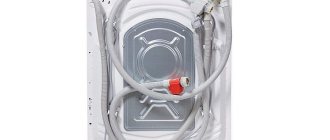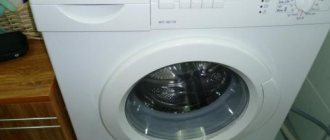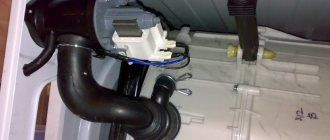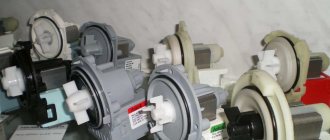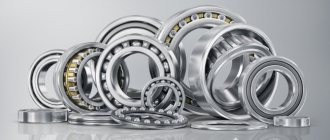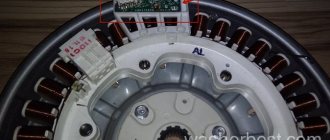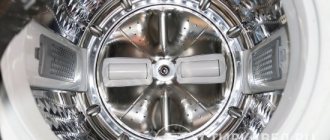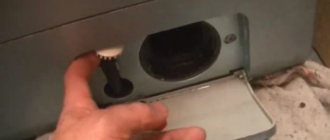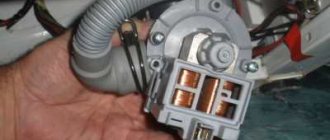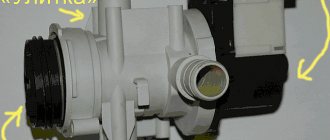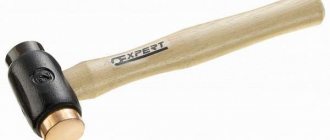Repairs such as replacing the drain pump (pump) of a washing machine, regardless of the model, can be done independently at home. To eliminate such a malfunction, you will need a small set of tools, namely: a flat-head and Phillips screwdriver, pliers and a tester for checking the winding for integrity. Before you begin such work, you must first make sure that the problem is in the drain pump.
Drain pump parts
Knowing how the pump works can significantly extend its service life and make repairs easier. The latter usually involves replacing the pump, which will necessarily require selecting an analogue. In order not to make a mistake with a new device, you need to take into account several important nuances: power, type of mounting and terminal diagram.
Modern automatic and semi-automatic machines are equipped with drain pumps with the following operational parameters:
- rated power – from 25 to 40 W;
- type of fixation on the cochlea - with a screw or latches;
- contact diagram - paired or separate terminals;
- type of pump - simple or circulation.
Pumps also differ in the filtration system they provide. Spiral filters are often used, which “hold” water in the pump when clogged. As a result, the dirty liquid stagnates and begins to smell unpleasant. You will have to check the nozzle, unscrew it and clean it of accumulated debris and scale.
As for the design of the pump, it consists of the following elements:
- plastic casing;
- rotor;
- impeller;
- magnetic core;
- winding.
The mechanism operates like an asynchronous motor, representing the interaction of moving and stationary elements. The system starts after the appropriate command from the control board: the module gives a signal, and the rotor - a permanent cylindrical magnet - begins to rotate. Then the impeller, located on the shaft at an angle of 180 degrees, unwinds. The blades move slowly, giving the water the desired direction. The magnetic core and two interconnected insulating windings remain static, maintaining the functioning of the system.
This is how a simple pump starts in a washing machine. Due to its elementary design, it breaks rarely and for easily removable reasons. More often, the impeller impeller falls off, causing the pump to run “idle.” Sometimes a blockage is to blame for the failure; extremely rarely, the core magnet weakens.
A circular pump differs in that it passes fluid only in one direction - to the “outlet”. The tightness of the device is achieved through an improved design. Thus, on Samsung washing machines, the pump is equipped with a sealing collar that covers the fitting and prevents water from entering the bearing assembly.
Modern pumps are also equipped with a rotor shaft passing through a central rubber bushing with a crimp - a spring ring. The structure is first generously lubricated with moisture-resistant lubricant. Due to the thick layer of sealant, all gaps are “closed”, which ensures smooth rotation of the mechanism, extending the service life of the pump.
Purpose of the washing machine drain pump
The water pump is designed in ASM to forcibly remove liquid from the tank at different stages of automatic washing. Structurally, the drain pump looks like this:
- small electric motor;
- shaft;
- impeller (impeller);
- snail, with a pipe connected to it and a drain hose.
- The automatic washing machine does not perform the rinsing procedure, the washed items are poorly rinsed, the machine does not rinse at all (stops).
- The waste water from the tank is not drained or takes a very long time to drain.
- The spin mode does not turn on.
- After washing, washing powder remains in the dispenser (partially or completely).
Replacing the pump in the SMA through the bottom
Before starting repairs, do not forget to turn off the power to the device and drain the remaining water from it by unscrewing the drain filter (place the tray, or place a rag under the bottom). The location of the pump may vary depending on the unit model. Thus, replacing the pump in washing machines from Indesit (Indesit), Samsung (Samsung), LG (El-G) occurs through the bottom of the unit: the bottom is not provided for by the design. A detailed algorithm for removing the pump in an Indesit washing machine is given here.
To remove the water pump, the SMA must be laid on its side and the front panel at the bottom, or the hatch door (like on an LG washing machine) opened.
Unscrew the two screws near the filter. These screws hold the entire structure (pump + volute).
Turn the snail clockwise and remove the assembly from the body. Then you will need to disconnect all wires and hoses, remove the bolts connecting the device to the snail.
Now you can disconnect the faulty pump and replace it with a new one, bolting it on. We reconnect the electrical wires, connect the pipes, insert the volute back into the body, and fasten it with screws. Close the front bottom panel. It is recommended to pour some water into the tank to check the tightness of the hose connections.
You can find out what the cost of replacing a pump in a washing machine is without calling a technician
Yes, of course you can. The cost of our work and the price for a new part can be found out in advance by phone. Name the brand of your machine: Bosch, Ariston or Indesit, and also name the brand modification, for example LG WD1052ND, we will select the necessary part specifically for your washing machine model, tell you its cost and the technician will come to you with the necessary spare parts.
Request a call
Benefits for you
Consultation about the malfunction and its cost
Each fault is unique. Tell us what your device is, and the dispatcher will inform you about the breakdown and the approximate cost of repairing it. It should be taken into account that the prices indicated are approximate, and the specialist will name the exact price after an accurate diagnosis.
Free visit of a specialist
The visit of a specialist is not paid even if the repair is refused. Diagnostics are also carried out free of charge when performing equipment restoration work.
We repair at home
Dismantling and delivery of the washing machine to the workshop is not required. Any work is carried out at your home. The specialists bring the necessary diagnostic equipment, spare parts and consumables with them.
Branded spare parts
For repairs we use only European-made spare parts. We provide a guarantee only for high-quality, certified parts and electronics.
We work from 9 to 21 hours daily
We can complete your application on any day convenient for you: morning, afternoon, weekend, evening. An urgent visit of a specialist to any area of the city at a designated time is not a problem for us.
Warranty up to 2 years
After the repair, a warranty card is issued for a period of 3 months to 2 years, depending on the service life of the machine and which pump was replaced.
How to choose a drain pump
For more information about the drain pump: where it is located in the washing machine, its operating principle and structure, you can read in this article: what is a water pump for a washing machine
When replacing a drain pump, you must choose a complete analogue in terms of design and technical parameters. All drainage devices differ both in power and performance, and in the method of fastening. You should only choose from proven and reputable manufacturers. Sometimes it happens that the connection of electrical wires to both the drain pump and the circulation pump may have a different location than those that have failed. This nuance usually does not matter and does not affect the installation of the element in its normal place. All replacement operations are carried out in the reverse order of dismantling, with mandatory quality checks of all fasteners and connections.
Breakdowns
In cases where the drain pump rotates, but does not pump water, this means that it is clogged, but not broken.
To determine if the pump is not working, it will be enough that the washing machine stops draining water, or does it poorly.
Also, a possible indication of a breakdown may be noise coming from the device while the washing machine is operating. First of all, it is worth understanding what the pump consists of and what is the reason for its failure.
The pump consists of three main elements:
- motor;
- filter;
- as well as the volute (pump housing).
If we talk about breakdowns, the motor coil very rarely breaks. More common causes of failure are either bearing wear or volute leakage. But in order to repair or replace the pump, you first need to remove it from the washing machine.
Signs of a broken washing machine pump
If problems arise with the pump, the machine can:
- do not respond to the installed program;
- make humming sounds when filling or draining water;
- pour water into the drum in less than the required quantity;
- During the process of collecting water, a complete shutdown of the equipment is possible.
To diagnose and, if necessary, repair or replace the machine pump, you need to:
- listen to how the machine works in order to identify extraneous sounds. If the machine makes a lot of noise when draining, it means there is water in the pump or some of its parts are deformed;
- open the socket to remove the blockage in the drain filter. All small and foreign objects are located here - hair, threads, buttons, seeds, etc.;
- clean the drain hose. Even if it doesn’t look damaged, you still need to remove it and wash it under hot water;
- check the operation of the impeller, it may be jammed. It is located behind the drain filter, which needs to be unscrewed and pulled out. The impeller blades will be visible and need to be rotated. The rotation should not be too easy. If there is any debris - bra knuckles, coins, threads and hair, it must be removed;
- check the integrity of the contacts and the functionality of the sensors going to the pump.
If during the diagnostic process the pump is identified as the cause of the problems in the washing machine, then you will have to inspect it. To get to it you will need standard tools.
Fault prevention
To avoid unscheduled repairs, you should follow a few simple rules:
- carefully inspect the laundry, do not allow small parts to get into the machine;
- Do not wash laundry that is too dirty, it is better to soak it first;
- Things that can cause a blockage (with long threads, lint, pellets) should be washed only in special bags.
In order for the machine to serve for a long time, you do not need to put in a lot of effort, just basic care and careful handling of it.
Symptoms of a problem
If the pump runs continuously for a long time:
- water continues to flow due to a failure of the fill valve, and the machine constantly pumps out excess water in order to prevent the drum from overflowing;
- the drain is poorly pumped (the filter is clogged);
- The electronic control on the washing machine ECU has failed.
The pump gets very hot from long, continuous operation. It turns off due to overheating - the thermal sensor will work. If this does not happen, it hums, which means that one of the components has worn out, such as the impeller or bearings, or one of the windings has shorted. It is possible that it crackles, buzzes or makes noise:
- the water being poured has poor pressure, and it takes in additional effort, noise is observed if the water has recently been turned off, a lot of air has entered the water supply system - its bubbles are currently leaving the water system;
- crackling and “shooting” - the winding has “broken” onto the motor housing or a foreign object has entered the pump;
- humming is a sign of a short-circuited turn in the motor winding.
You must immediately turn off the power and water supply, remove water from the machine, remove the laundry and disassemble the unit. The pump mechanism is often non-separable, but you can first “ring” the motor windings. And also check whether the drainage channels are clogged with debris, dirt or small objects.
Common causes of breakdowns
Users of automatic machines often encounter the problem of draining water from the unit and breakdowns of the drainage elements. Frequent “culprits” of the situation:
- Clogged pipes that carry used liquid into the sewer. Solving the problem is as easy as shelling pears - just clean the drain filter, pump and the so-called snail.
To do this you should:
- Disconnect the machine from the network.
- Drain the remaining water (usually no more than 1 liter) from the special hatch located in the lower part of the housing.
- Open the hatch, pull out the filter and clean it thoroughly.
- Install the filter element into the grooves, close the hatch and run a test wash.
- Pump failure. Violation of the integrity of the “electronic filling” can cause interruptions in the voltage supply to the pump. Checking the serviceability of the electronics is not difficult - you should remove the back panel of the unit and carefully inspect all the contacts and their connections. A simpler option is to use a special test device that allows you to determine gusts.
Does the pump vibrate too much during operation? It is quite possible that problems have arisen in the rotating part of the drain pump - the impeller. Replacing the broken part with a new one will help solve the problem.
If the water drains during the washing process, but the machine makes a lot of noise (usually there is a strong hum in the room), most likely the impeller in the device is jammed. In 95% of cases, such breakdowns occur due to foreign objects. To remove debris stuck in the parts, you need to remove the filter and snail using the method described above.
- Lack of engine power. Causes water to drain slowly from the drum.
How to get the pump
This is done quite simply. Most machines have a special compartment for the pump at the bottom of the machine. The pump is hidden behind a small rectangular panel, which can be removed by unscrewing the fasteners and prying it off with a screwdriver. Next, you need to find the self-tapping screw that holds the part inside the housing. It is usually located on the right side of the pump.
The next step is to prepare a container into which you can drain the water. This container will need to be placed under the washing machine, having first tilted the device. Only after this is it recommended to remove the pump, because water may leak from it.
To remove it, you need to push the part into the body of the machine and remove the pump through the bottom. You must first disconnect all wires and hoses.
Please note that not all models have the ability to shoot details like this. For detailed information, please see the instructions for your device.
Cleaning the pump
When the pump is in your hands, you can start cleaning. First you need to disconnect the impeller, which is attached to several self-tapping screws. It is in this part that a lot of dirt can accumulate, so cleaning starts from here. Then you can clean the snail, getting rid of all the blockages accumulated in it. Subsequently, everything must be collected and installed in its original place.
Assembly occurs in the reverse order, after which you will need to check the functionality of the machine. If everything is connected correctly, then the cleaning can be considered complete.
For your washing machine to work well, it needs periodic cleaning. When the user constantly uses the washing machine without caring about maintenance, sooner or later it will fail. If you hear a buzzing sound from the machine during the wash cycle and the water does not drain for a long time, the drain pump is clogged or faulty.
In this article we will look at where the pump is located in various models, how to check and clean it.
You can determine that the pump is clogged by external signs
Pay attention to these symptoms:
- Water drains poorly and slowly from the tank.
- When pumping water, noise and buzzing noises are heard. The pump tries to drain the water, but to no avail.
Why is the pump clogged, what contributes to this:
- Dirt and debris coming from a water pipe.
- Debris that gets into the water from clothes. These are buttons, coins, threads, hair.
- Bad detergents that do not dissolve during washing and clog the pump.
If the drain path in the SMA has never been cleaned, then it is not surprising that the pump is clogged. Let's look at how to fix the situation yourself and clean the car.
How to repair a pump in LG or Samsung models?
As an example, we will consider LG and Samsung washing machines with a load of up to six kilograms. These models can be found often, as they are very popular. They usually have a similar design:
- Open bottom without plastic or other protection. This arrangement makes it easier to maintain and repair the washing machine.
- Technical hatch in the lower right part. This door is made for replacing and servicing the coarse wastewater filter.
- A plastic cover on the front bottom of the washer that hides the fixing bolts.
There are more complex models for 8 or more kilograms . Such washing machines have special protection at the bottom, additional shock absorbers and water overflow sensors. These models are too complex for DIY home repairs and are not widespread, so their maintenance will not be considered in the article.
Disassembly
Disassembly should begin by turning off the device from the electrical network. It is worth checking that the tank is full. Sometimes pumps in washing machines break when the wash is in full swing and the device is filled with water. This point is worth considering so as not to collect soapy liquid all over the floor in the bathtub.
If the tank is completely filled with water, then you need to drain it into a basin. To perform this operation, you need:
- Raise the back of the machine above the floor at the height of your pelvis. You can add old books or boards.
- Then tilt the machine slightly onto its back so that its back rests against the wall and locks in this position.
- Carefully crawl up from the bottom and disconnect the inlet tube from the tank to the cochlea. In this case, you need to plug the hole in the hose with your finger so that water does not spill onto the floor.
- Place a basin under the machine and release the hose hole.
It is best to have two people drain the water, so that one person is always on hand. Moreover, a washing machine with a full tank of water will be very heavy. It is not easy to cope with such a task in one hand.
Another important point is primary diagnosis. Perhaps your machine does not require major repairs. To find out, you need to do an initial examination before preparing for the main work.
By doing repairs yourself, you automatically remove the warranty from your household appliance ! Remember this. If you are not confident in your abilities, take the machine to an official service center.
You can view instructions for disassembling washing machines of different brands here.
How to determine a breakdown?
If the water stops draining, and the machine works and turns on, you need to do a number of manipulations:
- Check the drain hose for bends and kinks. Perhaps in one of the places it has a bend - water simply cannot pass through this area.
- Listen to the machine work. If you hear a loud crunching or crackling sound in the bottom area during push-up mode, you should check the coarse filter. Perhaps it is simply very clogged and water cannot pass through in this place.
- Remove the filter and check the condition of the pump impeller. If it is in its place, try to scroll it. There are times when it simply gets stuck in one position.
- Check the contact on the pump. To do this, you will need to carefully lay the machine on its side and inspect the contact of the power wire to the pump. If necessary, you can remove the terminal from the socket and put it back in place. Then try to start the machine.
If none of the above cases apply, then you need to completely remove the pump and inspect it in place. Another possible breakdown is a gasket leaking at the point where the pump is connected to the volute. The pump works, but a puddle accumulates under the machine. It can only be eliminated after completely dismantling the pump.
Advice
Often the impeller blades get jammed or broken by small coins, paper clips, and other small items that people forget to take out of their clothing pockets. Carefully inspect all laundry before loading into the bin. With this simple method you can save a lot of money on washing machine repairs.
Dismantling
Removing the pump is easy. The main thing is to perform the initial preparation, disconnect the inlet hose to the water outlet. Next you need to do this:
- Open the technical hatch and remove the coarse filter. This may cause a small amount of water to leak out.
- Remove the protective cover at the bottom of the machine. To do this, you will need to pry off the latches in its upper and lower parts with a sharp knife. Take your time when removing the trim. Careless actions may cause damage to the mounting holes.
- Carefully place the washing machine on its left side to allow access to the bottom of the machine.
- Unscrew the fastening bolts under the trim. Typically there are two screws in these locations. You need to unscrew the bolts that hold the pump itself.
- Disconnect the pump from the power cord.
- Disconnect the pump from the volute.
Now you can thoroughly examine the entire unit and repair it.
Before removing the pump from its seat, take a photo of it on your phone or other gadget. This will help you when installing the pump in place after the repair (how to repair a washing machine pump yourself?). Otherwise, you may install the pump incorrectly. This will affect her productivity.
Procedure
- The first thing you should pay attention to is keeping the impeller on the axis. Sometimes the fastening splines on it break off, and it simply stops holding in place. Rotate the impeller with your fingers and check the movement. If the part rotates freely or flies off the axis, you need to order a new impeller.
- The second is a direct inspection of the electrical part of the pump. Check the integrity of the winding coils that drive the pump rotor. Carefully inspect them for burning or broken copper wire. If there are breakdowns or you can see an open burn on the winding, you should order a new unit as a whole, since repairing such a fault will not have a positive effect, but will only take time.
- Inspect the contact group where the terminal is connected. Sometimes an oxide film forms in these places. Perhaps the problem is in this place, you just need to clean the contacts.
- Check the electrical circuit of the pump motor. Test it with a voltmeter to check for broken contact. If the device is silent, it means there are breaks in the electrical circuit of the pump.
Checking the impeller
A blocked impeller also prevents complete drainage. A key forgotten in your pocket or a bone that has jumped out of your bra can jam the pump blades and stop the washing machine from working. Fortunately, it is not difficult to detect and fix a malfunction of this type.
In most cases, repairs can be made without disassembling the washing machine. It is enough to unscrew the drain filter and illuminate its seat with a flashlight. At the end of the “tunnel” you will see the pump impeller - a plastic wheel with blades. Insert your fingers into the hole and try to get it moving.
- If the impeller does not rotate, you need to feel for the stuck object. Very often, its role is played by a ball of hair or fur, a coin, the mentioned bone or wire. Once the foreign body is removed, the problem will be solved.
- If the impeller spins but periodically slows down, then the problem is burnt out or loose contacts. A faulty control board also negatively affects the rotation of the “wheel”.
When the inspection does not produce results - the impeller rotates freely or stands still, but without visible interference - you will have to disassemble the washing machine and remove the pump. For further diagnosis, you need to pick up the pump.
Why is the drain pump most often beyond repair?
For two reasons. Firstly, most washing machine manufacturers install non-separable drain pumps. And secondly, for models with a dismountable pump, separate repair kits are still not available. Therefore, it is possible to repair the pump only if all its parts are intact, and the pump is simply clogged: small objects (thread, toothpick, sock, handkerchief, etc.) have gotten into it, which prevents the normal rotation of the impeller.
Note! If the blockage is not cleared in time, this can lead to overload of the pump motor and its failure or damage to the impeller. Therefore, if the first signs of a malfunction appear, it is recommended to call a specialist as soon as possible, because in this case, there is still a chance to get by with repairs, which are cheaper than replacing the part.
Types of faults and repairs
If a Samsung washing machine is constantly used, then over time there will come a time when it will not turn on. The cause of the problem may lie in the water pump, which will need to be removed. Therefore, it is advisable for every unit owner to know how to check and change the pump, as well as clean and replace the filter.
If you hear an unusual noise from the unit, you should try to disassemble it. To carry out this procedure, it is worth knowing the design of the equipment, the nuances of connection, only then will it be possible to repair the housing or correct the situation when the impeller flies off.
Depending on the wash cycle, the pump may turn on and off several times. Due to high load, this element may fail. Malfunctions of Samsung equipment pumps include the following:
- frequent connection of thermal protection on the electric motor winding;
- clogged impeller, which often causes interruptions in operation;
- impeller blades broken by mechanical force;
- wear of the bushing located on the motor shaft;
- scrolling and falling out of the impeller;
- occurrence of short circuits;
- breakage of the turns that are located on the motor.
Each of the above breakdowns can become the basis for repairing the pump. It is often recommended to carry out repair procedures when minor damage is detected, for example, debris getting into the impeller or minor damage to the blade. All other problems require replacing the pump in the washing machine.
Since the pump is located in the lower half of the car, under the tank, it can be reached through the bottom or after dismantling the front panel. Replacing the pump in Samsung technology must be done through the bottom.
Dismantling the pump includes the following activities:
- disconnecting the machine from the electrical network;
- shutting off the water before performing procedures;
- carefully lay the machine on the side - so that the pump is located on top;
- releasing the bottom of the equipment from the protective panel - to do this, remove the snap fasteners;
- dismantling the protective casing;
- unscrewing the hub fastening screws that are located near the valve;
- carefully pulling out the pump;
- disconnecting the pump supply wires;
- loosening the clamps that secure the hoses, which are located above the prepared container;
- detachment of the cochlea, if any.
The unit should be reassembled in the reverse order. The process of replacing the technical unit of a Samsung washing machine will not take much time. You can do all the work yourself or contact a specialist. According to the advice of professionals, when replacing a pump, you should use original parts, since others may not only fail to eliminate the malfunction, but also cause irreparable damage to the machine.
In order for the pump to work for a long time and without interruptions, it is necessary to regularly monitor its condition and follow these recommendations:
- before washing, you need to check all pockets in your clothes to prevent various objects from getting into the pump;
- use only high-quality special laundry detergents that contain anti-scale additives;
- install a filter on the water supply, which will limit the penetration of rust particles into the unit;
- Before washing excessively soiled items, it is recommended to soak them.
The washing machine pump is the heart of the unit, the operation of which determines the quality of washing, rinsing and spinning. All owners of Samsung equipment should remember that as soon as the machine begins to work worse or noticeable signs of breakdown appear, you need to immediately begin repairs.
Samsung washing machine pump repair is presented in the video below.
Where is the pump located
Models of washing machines Candy, LG, Whirpool, Ariston, Beko, Samsung are equipped with a pump located at the bottom.
To get to it, the washing machine is laid on its side and the bottom panel is removed. The snail with the filter is attached with screws that can be unscrewed and the required part is in your hands. If we talk about Zanussi and Electrolux models, their pump is located behind the back cover, which will need to be removed.
The most difficult models to disassemble are Bosch, AEG, Siemens. They will have to dismantle the entire front panel.
The best pump for an LG washing machine or another model
To get to a failed drain pump, it is not at all necessary to disassemble the entire washing machine. Repair will depend on the model of the washing machine and its manufacturer. It is very easy to get to the pump of washing machines from some manufacturers, but with others it will be more difficult.
It’s easy to get to the washing machine pump:
- Samsung;
- Candy;
- Ariston;
- Ardo;
- Beko;
- Whirlpool;
- LG;
- Indesit (Indesit).
Pump for an LG washing machine
To do this, you need to put the machine of one of these brands on its side, remove the bottom cover (if there is one), and the pump will be at hand. The lid is very easy to unscrew. The situation is a little more complicated with washing machines such as Electrolux and Zanussi.
The most difficult thing to change is washing machine pumps from manufacturers such as AEG, Bosch, Siemens. In this case, you will have to remove the front wall together with the control panel.
How to call a specialist
You can call a RemBytTech specialist from 8 a.m. to 10 p.m. every day, including weekends and holidays, by phone or using the online form on the website (24 hours a day).
When contacting the RemBytTech workshop, please inform:
- The brand and, preferably, model of the washing machine on which the pump needs to be replaced. For example, Bosch Maxx 5 or Samsung S1005J. The exact model name can be found on the sticker on the body of the washing machine. This is required so that the technician takes with him a part suitable for your washing machine. If you have already bought a new drain pump, it is enough to indicate only the brand of the machine.
- Convenient day and time for the specialist to arrive.
- Your name, address where repairs need to be carried out, and telephone number.
On the day you set, the specialist will call you back to confirm the time of arrival.
Is it difficult to change a part?
You can replace the pump of a Samsung washing machine yourself
It is important to select a replacement element that fully matches the standard one. When the original cannot be found, it is allowed to install an analogue
When choosing a pump, you need to focus on the following characteristics:
- power;
- snail fastening method;
- number of latches or mounting holes for bolts;
- connection method (chip or terminals).
The pump replacement algorithm is as follows:
- disconnect the two power wires going to the pump by removing the terminals;
- unscrew the bolts securing the pump to the volute;
- remove the pump from the housing;
- connect the new pump to its original place in the same position, secure it with self-tapping screws;
- connect terminals, wiring;
- place the SMA in its original position;
- Screw in the garbage filter and close the protective hatch.
Afterwards, you can connect the machine to communications, plug it in and start a test wash. Thus, it is possible to diagnose and replace the drain pump at home, without calling a technician
It is important to strictly follow the rules and instructions for action
Share your opinion - leave a comment
Design and operating principles of AFM
Household ASMs have 2 types of loading dirty laundry, frontal and vertical. Both have advantages and disadvantages, but at the same time leaving the general principle of operation and the composition of technical elements unchanged. The outer body of the washing machine is a metal frame with a top cover and base, front and side panels, and a rear wall made of plastic, inside of which there are units and components that operate the automatic washing machine. Different models may be equipped with additional equipment.
Components and mechanisms without which the washing machine cannot operate:
- tank;
- drum;
- frontal counterweight;
- electric motor;
- drive belt and driven drum pulley;
- suspension springs and shock absorber;
- TEN (thermoelectric water heater);
- liquid level switch;
- fill valve;
- dispenser hopper;
- hatch blocking device (UBL);
- seal (cuff) of the hatch;
- ECU (electronic control unit);
- drain hose and drain pipe;
- pump (drain pump);
Major breakdowns in AMC Samsung S621 and WF6450S7W.
Like any other household appliance, washing machines can fail (break). The reason for this may be violation of operating rules, poor-quality detergents, overload, mechanical damage, and so on. Some of the breakdowns can be easily fixed on your own, others will require a lot of effort, and the third category of faults is one that will require the intervention of a specialist. The most common breakdowns that you can repair yourself are:
- machine failure will turn on;
- leaks
- Spin does not work;
- the water does not heat up;
- water does not drain from the tank.
Expert advice
Professional technicians who service machines know several causes of breakdowns that do not lie on the surface, but affect the performance of the pump:
- Particularly “bouncy” machines can fray the power supply wires of the pump during washing. Then the pump will appear to be in good working order, but will not work and spin. To diagnose this problem, you will need to disassemble the device down to the electronic control unit. This repair is quite labor intensive. Only a master can handle it; a beginner cannot repair it.
- In some cases, the electronic control unit program may fail. Such diagnostics and repairs can only be performed by a professional technician with special equipment.
- Another rare malfunction is a blockage in the hose running from the main tank to the volute with the pump. It can be determined by hand, squeezing different areas in turn. If necessary, the hose can be removed and cleaned under strong pressure from the tap.
Most often, technicians check the contact group and the pump impeller. If the cause of the breakdown does not concern these parts, the specialist simply replaces the entire assembly.
You can repair the washing machine pump yourself. This is a simple operation, especially if you have an assistant
When working, you need to take precautions, do not forget about the remaining water in the tank and do not try to repair or solder the pump, unless it concerns the impeller or contact group
Washing machines have long become indispensable in everyday life. For smooth operation, you need to install it correctly. Well, if a breakdown occurs, read our articles on how to repair or replace a drum, pump, drain and pressure switch, bearings, heating element, tank.
Our advantages
- Free repair consultation . RemBytTech specialists are ready to give professional advice online in the Questions and Answers section. It is enough to describe your problem in detail, and a specialist will respond within 48 hours. You can also leave a repair request: the technician will contact you by phone and advise you on possible breakdowns of your washing machine and the cost of fixing them.
- Free visit and diagnostics . If you agree to repair or replace the pump by RemBytTech, a specialist visit and diagnostics of the machine are free.
- Repair at home within 24 hours after calling the specialist . Thanks to the territorial presence of specialists in all districts of Moscow and most cities of the Moscow region, we service orders in the shortest possible time - within 24 hours after the request. All work is carried out at the customer’s home; there is no need to take the equipment to the workshop.
- Opening hours daily from 8 a.m. to 10 p.m. Our technicians visit clients’ homes from early morning until late evening, seven days a week and seven days a week. You can easily choose a repair time that is convenient for you.
- 6 month warranty . The work required to replace the washing machine pump is provided with a 6-month warranty (for labor and for spare parts, if the technician installed his own parts).
What to do if the pump (pump) breaks down in a Samsung washing machine?
The Samsung washing machine drain pump is designed to remove waste water from the machine. Pumps differ in the type of attachment to the volute and in power. The pump for a Samsung washing machine lasts on average 5-6 years (the same as for a washing machine in a small bathroom), however, if the washing machine is not treated properly, it can quickly fail.
Signs of a pump malfunction are:
- The washing machine does not drain water (a common problem with the Samsung WF0400 washing machine).
- The washing machine drains water very slowly (a common problem with washing machines with a drying function).
In what cases is it necessary to replace the drain pump?
The drain pump is replaced only if all problems associated with draining water cannot be avoided by other means. One of the unpleasant breakdowns when you have to drain water from the tank manually is a violation of the drainage of water into the sewer. However, the pump is not always the cause. First of all you need to check:
- Is the “no drain mode” option enabled?
- drain hose, check for blockages or kinks;
- drain filter, where various small objects that fall into the tank along with the laundry are often collected;
- drain pipe where small items or clothing could get stuck;
- control module, in which failures may occur both in the software and in the operation of the electronic part;
- operation of the pressure switch.
There are many reasons why a washing machine does not drain water at the end of the washing or rinsing process, and the problem must be approached comprehensively. Detection and elimination of malfunctions should be carried out according to the principle “from simple to complex.” Do not immediately disassemble the device. Sometimes it is enough to press a button to turn off the “no drain” mode or simply clean the filter. Typical signs of a pump malfunction include:
- “transformer” strong hum in the area where the pump is located when there is no water drainage;
- water flows out of the drain hose with very little pressure;
- Error information is displayed on the machine display.
Many modern units are equipped with a self-diagnosis system and are able to signal failures and malfunctions in the system. Each manufacturer has its own error codes, which are indicated in the passport of the washing machine. For example, for Ariston, a malfunction of the drain pump is signaled by code F05. If the applied diagnostic methods lead to the conclusion that the pump is faulty, it must be removed and replaced with a working one.
Symptoms of a problem
If the pump runs continuously for a long time:
- water continues to flow due to a failure of the fill valve, and the machine constantly pumps out excess water in order to prevent the drum from overflowing;
- the drain is poorly pumped (the filter is clogged);
- The electronic control on the washing machine ECU has failed.
The pump gets very hot from long, continuous operation. It turns off due to overheating - the thermal sensor will work. If this does not happen, it hums, which means that one of the components has worn out, such as the impeller or bearings, or one of the windings has shorted. It is possible that it crackles, buzzes or makes noise:
- the water being poured has poor pressure, and it takes in additional effort, noise is observed if the water has recently been turned off, a lot of air has entered the water supply system - its bubbles are currently leaving the water system;
- crackling and “shooting” - the winding has “broken” onto the motor housing or a foreign object has entered the pump;
- humming is a sign of a short-circuited turn in the motor winding.
You must immediately turn off the power and water supply, remove water from the machine, remove the laundry and disassemble the unit. The pump mechanism is often non-separable, but you can first “ring” the motor windings. And also check whether the drainage channels are clogged with debris, dirt or small objects.
How to prevent pump failure
If you follow these recommendations, you can significantly extend the life of the drain pump.
- Always remove foreign objects from pockets before washing.
- Use bags for washing clothes.
- In case of strong, coarse dirt, clean things, and also remove animal hair by hand before entering the machine.
- Install filters at the inlet of the filler pipe.
- Carry out scale prevention.
- When washing items with buckles or rivets, turn the items inside out.
Source of the article: https://stiralnihremont.ru/polomka/remont-nasosa-stiralnoj-mashiny-svoimi-rukami/
